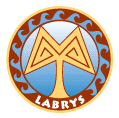
email
PO Box 18341
Sarasota FL 34276
1.888.362.3133 |
About
LABRYS
LABRYS
Publishing was founded in Berkeley, California in
1997, with the publication of The Coming of a
New Millennium. In 2000, LABRYS acquired the
rights to the screenplay, Knossos: Return to the
Labyrinth, and added a new film production division.
Our main office moved to Sarasota, Florida the same
year. 2004: An Olympic Odyssey is our second
title.
The symbol
of the labrys appears in many cultures throughout
prehistory, but is most often associated with the
great Temple at Knossós on the island of Kríti.
The ancient Minoans carved it on walls throughout
the stone corridors of Knossós, and as a result,
this remarkable structure became known as the Labyrinth
– the dwelling of the labrys. Since the word
“labrys” is of pre-Indo European origin,
we don’t know exactly what it meant to the Minoans,
but there is little doubt that it was of great importance
to them. Archeologists have recovered hundreds of
small bronze labryses, as well as numerous artifacts
which bear the image, including exquisite gold jewelry
and tiny sealstones.
In Neolithic
art, the Great Goddess of prehistory was sometimes
represented as a double triangle, in an hourglass
configuration, which when tipped on its side bears
a close resemblance to a labrys. The symbol itself
could therefore recall the time when the Civilization
of Old Europe thrived.
The labrys
has often been referred to as a “double ax.”
However, during Minoan times, there is no evidence
that it was used as a weapon, or to perform ritual
sacrifices. On the contrary, nearly all of the labryses
found at Minoan sites are decorative in nature, and
many were discovered in rooms where sacred rituals
are believed to have taken place. Perhaps the symbol
was a reminder of the double edged nature of technology.
In their time, bronze was the technology of the day,
and most warrior cultures were using it to make stronger
and more deadly weapons with which they could carry
out their conquests. The Minoans, however, chose to
use the metal to make ritual objects and more durable
tools, in order to further the common goals of the
entire community. Did they understand that technology
in and of itself was neither good nor bad, but rather
could be used to create or destroy? By making the
labrys a central part of their rituals, it’s
possible they were reaffirming their conscious choice
to use the new technology for altruistic purposes.
The symmetry
of the labrys also suggests the idea of yin-yang,
the balance between the masculine and feminine energies,
which together, make up the whole within each of us.
The Interpretive
Guide to 2004 goes into much more detail
about this symbol, and it also includes the mythological
characters and places referenced in the novel. |